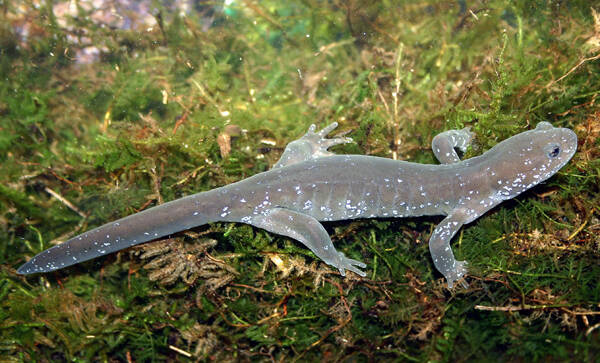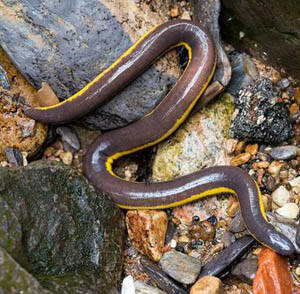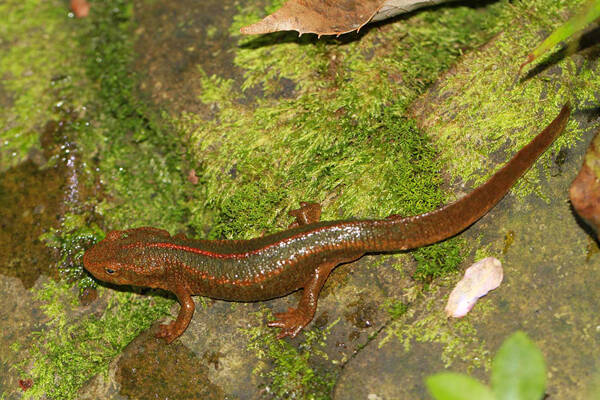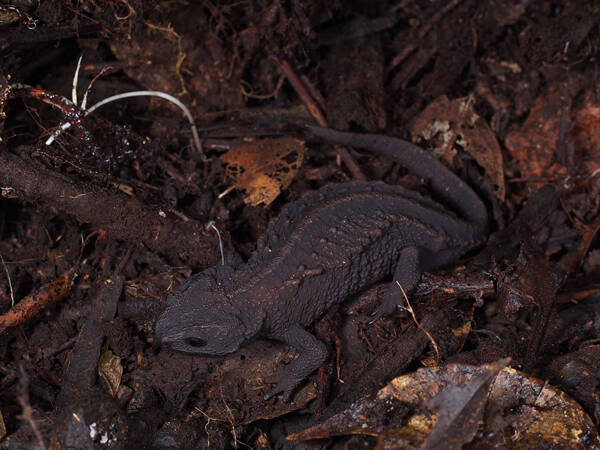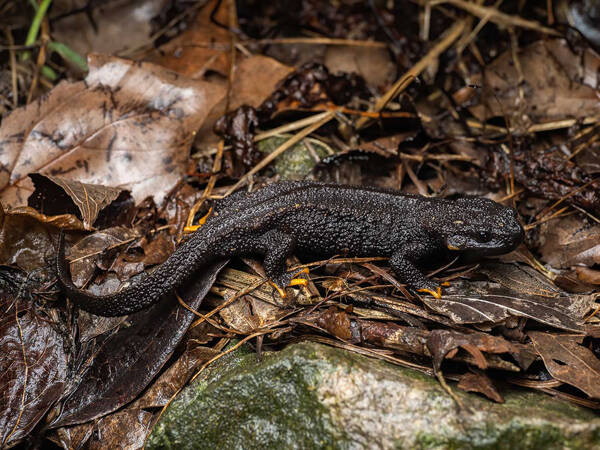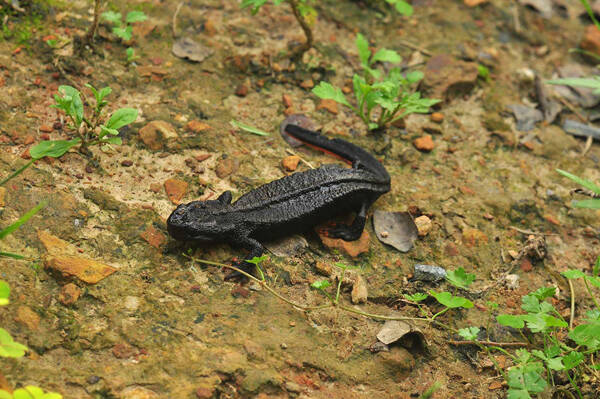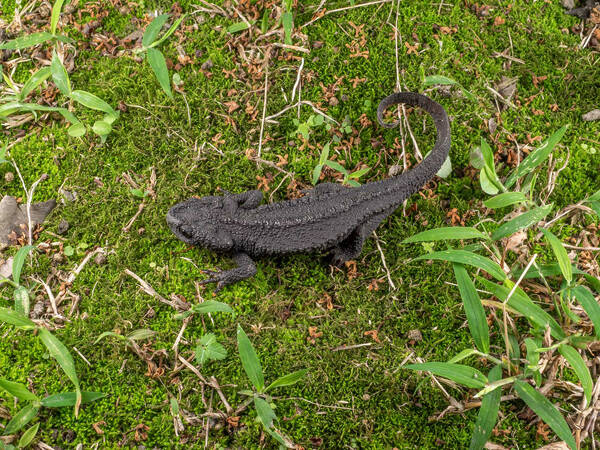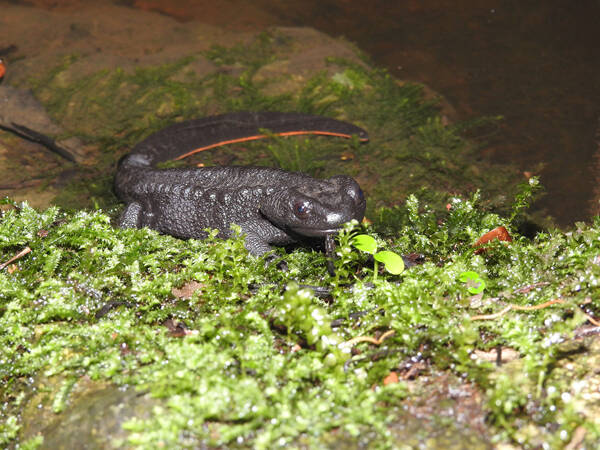Hynobius guabangshanensis
IUCN
LCBasic Information
Scientific classification
- name:Hynobius guabangshanensis
- Scientific Name:Hynobius guabangshanensis,South Henan Small Salamander, Qishan Little Elf, Qiyang Small Salamander, Giant Salamander
- Outline:Urodela
- Family:Caudata Hynobiidae
Vital signs
- length:125.4~151.0mm
- Weight:
- lifetime:
Feature
It is similar to the Anji Hypsilophis davidianus, but this species is smaller in size. Its back is black or dark brown when alive, and slightly yellow-green under sunlight.
Distribution and Habitat
Endemic to China, distributed in Hunan (Qiyang Guabang).
Lives in mountainous areas with trees and shrubs at an altitude of about 720m.
Appearance
The head is oval, the length of the head is obviously greater than the width of the head, the snout is rounded, and there is no lip fold; there is no fontanelle, and the vomerine tooth row is V-shaped or V-shaped. The trunk is cylindrical, slightly flat on the ventral side; the base of the tail is slightly round, with dorsal and ventral fin folds on the tail, which gradually becomes thinner backwards, and the tail end is round. The back of the body is black or yellow-green, waxy, and has no spots; the ventral side is gray and slightly purple-red, with many small white spots.
Details
The Guabangshan Small Salamander lives in Guabangshan in Qiyang, Hunan. The highest peak of the mountain is 788 meters above sea level. Below 400 meters above sea level is the rice field area, and a few rice fields can reach about 600 meters. The salamander mainly lives in small mountain ponds, swamps and their vicinity at an altitude of about 720 meters. The vegetation in this mountain area is mostly fir forests, bamboo forests, oil tea forests, shrubs and thatch. During the non-breeding period, the salamander lives on land. Adult salamanders mostly live under thick layers of dead branches and leaves on land and in soft soil. Local farmers occasionally dig them out when raking or digging the soil.
In terms of activity, the Guabangshan Small Salamander mostly moves in the cool and moist places of bushes, streams and ponds. The body color of this small salamander can be coordinated with the surrounding environment, so it is not easy to be discovered by enemies. The Guabangshan Small Salamander is relatively agile. When moving slowly, the four limbs support the body off the ground and crawl only on four feet. When moving at high speed, the four limbs do not move, and the body muscles twist and meander forward. The Guabangshan Small Salamander is relatively timid by nature. It is difficult to find the activity of the small salamander in places where human activities are frequent. It is a cold-blooded animal that is afraid of heat and likes warmth. Therefore, it is less active during the day in July and more active during the day in winter. However, when the mountain is closed by heavy snow, it enters a semi-hibernation state and hides in caves and cracks in rocks. In addition, adult Guabangshan small salamanders like to live alone, while juvenile Guabangshan small salamanders like to live in groups, often with several young salamanders living together.
In terms of feeding behavior, Guabangshan small salamanders are carnivorous and hunt fiercely. They use their forelimbs to find and prey on insects, earthworms, and small arthropods. They can go without eating for several days after eating a full meal. Their appetite is huge. Young salamanders feed on water earthworms, algae, and rotifers. If food is scarce, they cannibalize each other.
In terms of reproduction, the spawning season of the Guabangshan salamander is between the beginning of winter and the beginning of spring, mostly in the middle of the night. When the Guabangshan salamander reproduces, the male Guabangshan salamander will choose a breeding site, generally a pond or rice field with an area of 50 to 60 square meters, a water depth of 20 to 30 centimeters, and relatively fresh water. After that, the male Guabangshan salamander will lure the female Guabangshan salamander into the spawning site, and after a period of play and chasing, they will mate for in vitro fertilization. The female Guabangshan salamander will leave quickly after laying eggs, while the male Guabangshan salamander will guard on the side. Generally speaking, there is one Guabangshan salamander guarding a pair of egg sacs, and they will leave after 3 to 7 days. A female Guabangshan Small Salamander lays a pair of egg sacs, which are basically attached to water plants, rocks or the bottom of the water. The diameter of the newly born egg sac is about 20 mm and the length is 60 mm. After birth, the egg sac quickly absorbs water and expands. Generally speaking, it can be up to 150-180 mm in length and 50-54 mm in diameter after 10 days. A pair of egg sacs contains 120-165 eggs, each with a diameter of 2-2.5 mm. The fertilized eggs of Guabangshan Small Salamander develop relatively slowly and are very sensitive to the water temperature in which they live. It takes 43-60 days for Guabangshan Small Salamander to break the membrane and be born from the fertilized egg state. The young salamander lives in the water for 80-100 days. Generally, the gills will be removed and lungs will grow from the beginning of summer to the full harvest, and gradually begin to live on land.
The Guabangshan Small Salamander grows slowly, has a low reproduction rate, is slow to mature sexually, has a low in vitro fertilization rate, and can only hatch and metamorphose in water. It takes a long time to develop and has a weak self-protection ability. Therefore, it is easily affected by environmental factors such as natural enemies, water bodies, atmosphere, and bait. According to statistics, the survival rate of Guabangshan Small Salamander from fertilized eggs to sexual maturity is only 1/1000.
It is listed in the first level of China's "National Key Protected Wildlife List" (February 5, 2021).
